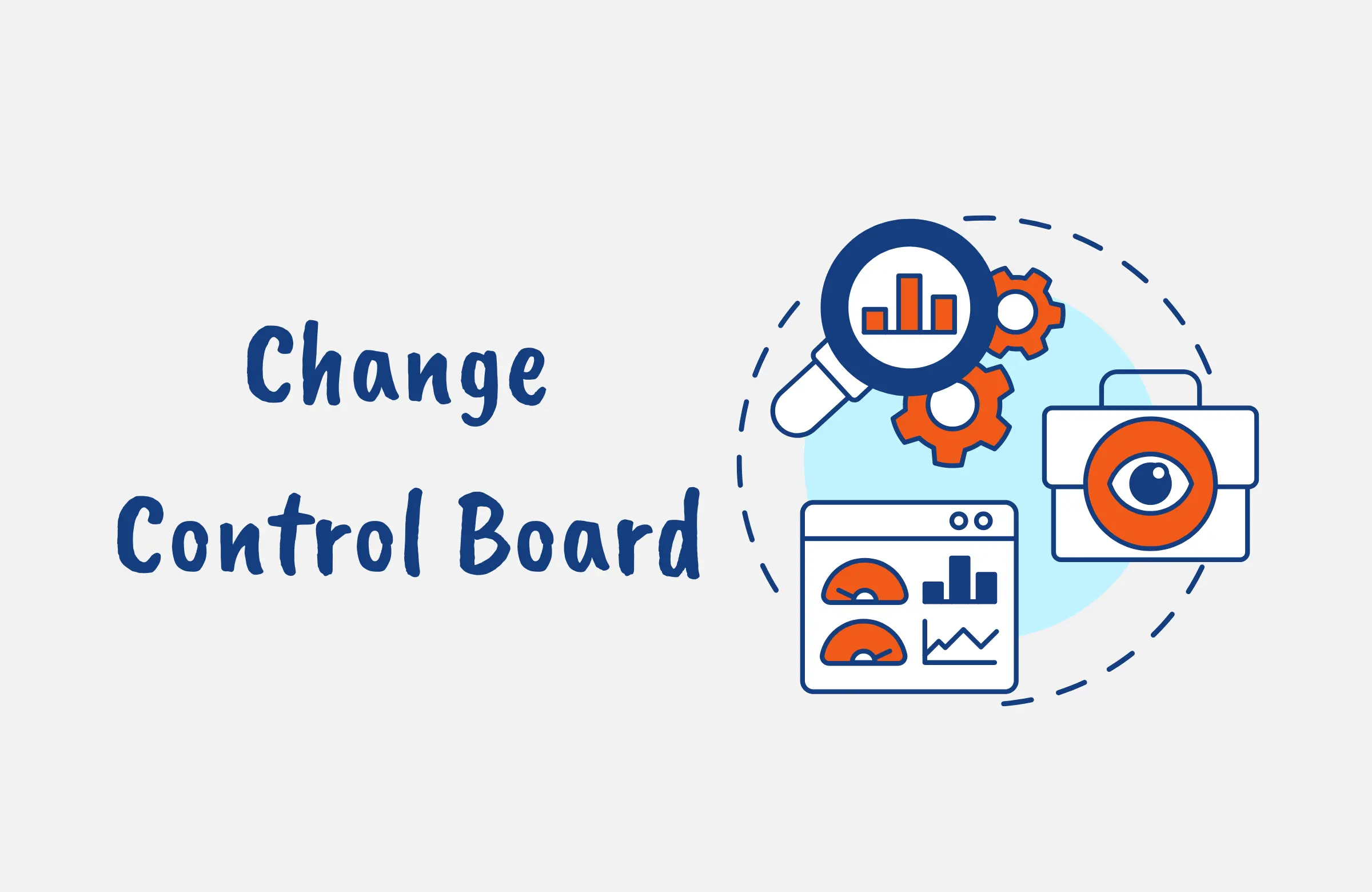Changes are an inevitable part of project management and they need to be planned for and managed.
A Change Control Board (CCB) is an important component of effective change management in any project.
This group oversees proposed changes, evaluates potential impacts, and decides whether to approve or reject alterations to the project plan.
In this article, we cover what a Change Control Board entails, typical members of the board, their responsibilities, and tips on creating an effective board. We’ll also look at best practices for change control to ensure seamless project management.
Project Change Management
Project change management is the process of identifying, evaluating, approving, and implementing changes to a project.
It includes both the mechanics of processing change requests as well as the tools and techniques used to manage stakeholders as changes are introduced.
Effective project change management requires clear processes for submitting and logging change requests, assessing impacts, obtaining approvals, updating project documents, and communicating changes to the team.
Following established change management procedures helps minimize disruption and keep projects on track when changes inevitably arise.

What is a Change Control Board (CCB) in Project Management?
A Change Control Board (CCB) is a group of stakeholders who oversee proposed changes for a project or organization.
They’re responsible for evaluating potential changes, assessing their impacts, and determining whether to approve or reject them.
The CCB acts as a gatekeeper for changes to ensure they are carefully considered before implementation which helps maintain the project scope, schedule, and budget.
CCBs are typically cross-functional and include representatives from key departments like project management, finance, technical teams, and quality assurance. Members review change requests, provide recommendations, and vote on final decisions.
An effective CCB has defined processes for submitting, reviewing, and making timely decisions on proposed changes. They meet regularly to consider change proposals and provide guidance to project teams.

Change Control Board Charter
The Change Control Board charter is a document that defines the purpose, authority, composition, and operating model of the board.
It serves as a guide for board members to ensure consistent change control governance, helps new members onboard, and aligns the group to work effectively.
An effective CCB charter clearly outlines the following:
- CCB mandate and scope
- Membership criteria
- Member roles and responsibilities
- Decision-making process
- Protocols for meetings
- Change request intake procedures
- Standards for change evaluation
- Authority for approving/rejecting changes
- Change implementation process
- Reporting and documentation

Change Control Board Process Flow
This standardized process flow enables the CCB to effectively evaluate potential changes, make informed decisions, and provide oversight from the proposal through implementation.
The CCB typically follows these steps in their change control process:
- Change request submitted to CCB
- Request logged and documented
- CCB reviews request
- Impacts analyzed (e.g. costs, timeline, quality, resources)
- CCB discusses the merits of the proposed change
- Decision made to approve or reject
- Decision documented
- Approved changes incorporated into project artifacts
- Relevant stakeholders notified of decision
- Change implemented per defined process
- CCB validates implementation
- Lessons learned captured

Change Control Board Responsibilities
The Change Control Board (CCB) has several key responsibilities within the change management process including:
- Review New Change Requests: The CCB is responsible for reviewing all change proposals and requests that are submitted. This may include changes to project scope, budget, timeline, or deliverables.
- Analyze Impacts of Proposed Changes: For each change request, the CCB must thoroughly analyze the potential impacts on the project if the change is approved. This includes scope, schedule, cost, resources, and risk impacts.
- Make Approval/Rejection Decisions: Using the impact analysis, the CCB decides whether to approve or reject each proposed change. Their goal is to only allow changes that benefit the project’s overall objectives.
- Document all CCB Decisions: To maintain visibility, all CCB change decisions must be properly documented with context and rationale.
- Communicate Decisions: The CCB informs requestors and relevant stakeholders whether proposed changes were approved or rejected.
- Monitor Implementation: For approved changes, the CCB oversees the execution and tracks them through to full implementation.
- Maintain CCB Processes: The CCB is responsible for managing and upholding all defined change management processes, procedures, and policies.
- Report to Project Governance: The CCB provides regular status updates and change summaries to key project governance entities.

Typical Change Control Board Members
A typical CCB should have a balanced representation covering the project management, technical, and business domains.
Members must have the authority to make decisions relevant to their area, and the group size should facilitate discussion but not be too unwieldy.
The composition of the CCB depends on the organization and project specifics, but some typical roles include:
- Project Manager: Leads CCB meetings, facilitates group decision-making, and ensures alignment with project objectives.
- Project Sponsor: Represents business needs and has the authority to approve/deny changes.
- Finance Representative: Assesses financial impacts and viability by considering costs, budgets, and resources.
- Technical Experts: Evaluate feasibility, efforts, and risks of technical changes.
- Quality Assurance: Identify potential quality, compliance, or validation impacts.
- Development Team Leads: Understand implementation implications and efforts required.
- Business Analysts: Analyze change impacts relative to requirements.
- End Users: Represent needs and perspectives of user groups affected.
- Customers: For customer-facing projects, customer advocates weigh in on changes.

Best Practices for an Effective Change Control Board
Following structured processes with documented policies enables the CCB to work effectively and consistently manage change across projects.
Here are some key best practices to establish a high-functioning change control board (CCB):
- Clearly define the CCB’s charter and scope of authority. Document its mandate, responsibilities, decision protocols, and relationship to project governance.
- Ensure CCB membership provides balanced representation across business, user, and technical domains. Include members who can assess impacts across the key project areas.
- Outline formal policies and procedures for the change management process, request intake, CCB meeting cadence, decision-making, and communications.
- Implement a structured process for change requests including request templates, impact analysis, and standardized evaluation criteria.
- Institute formal documentation practices for CCB decisions, meeting minutes, and change logs. Maintain an audit trail.
- Establish recurring CCB meeting cadence, clear meeting management protocols, and orderly decision-making procedures.
- Make CCB information visible to stakeholders through regular communications and transparent change logs.
- Set expectations for change requestors to attend CCB meetings and provide adequate background/supporting materials on proposed changes.
- Train CCB members on their roles and responsibilities, project objectives, and the change management process.
- Leverage tools to automate change traceability, impact analysis, and notifications.
- Review and continuously improve the CCB operating model based on metrics and feedback.

Mistakes to Avoid with a Change Control Board
While a properly instituted Change Control Board (CCB) can greatly benefit project governance and oversight, CCBs can fall short if not established and run effectively.
Here are some of the most common pitfalls to avoid:
- Failing to Define the CCB Charter and Policies: A CCB without clearly articulated purpose, roles, responsibilities, processes, and decision protocols will struggle. Taking the time to define policies and charter sets the stage for success.
- No Formal Change Request Processes: Loose intake procedures lead to poorly defined requests. The CCB needs to institute standardized request templates, required impact analysis, and intake mechanisms to enable informed decisions.
- No Set Meeting Cadence: Ad-hoc meetings make it difficult to align schedules and prepare. The CCB should establish consistent meeting frequency such as weekly or monthly to provide predictability.
- Lack of Balanced Representation: A CCB missing key functions like Finance, Technical, Quality, or user risks skewed perspectives, and inadequate impact analysis.
- Unclear Decision Authority: Who ultimately decides on change approvals? The CCB must define protocols such as majority rules, delegation, or tie-breakers. Ambiguity causes gridlock.
- Poor Tracking and Documentation: Without proper record-keeping, decisions can get lost leading to misalignment. Document meeting minutes, change logs, impacts, and rationale.
- Deciding Based on Influence: CCB decisions should be objective and fact-based using defined criteria, not based on politics.
- Uncommunicated Decisions: Failing to inform requestors and stakeholders of CCB decisions breeds confusion. Formalize communications channels.
- Not Monitoring Implementation: The CCB cannot assess effectiveness without monitoring the execution of approved changes.
- Lack of Continuous Improvement: Regular assessments of CCB performance and outcomes provide critical input to improve. Incorporate audits, metrics, and maturity models.

Change Control Board in Agile
The Agile approach values responding to change over strict adherence to plans. While the CCB may seem at odds with Agile principles, it can still provide value.
- Focus CCB on prioritization vs approvals. While the Product Owner prioritizes the backlog, the CCB can evaluate the cross-team impacts of changes.
- Empower teams to make minor changes, only escalating major changes to CCB.
- Utilize lighter-weight change processes. Agile limits documentation, so streamline request templates and impact analysis.
- Adjust membership and meetings to fit Sprint cadence. Include representatives from Scrum teams.
- Maintain visibility through a shared change log vs formal approvals.
- Leverage CCB for education on change impacts as teams learn agility.
With these adaptions, the CCB can complement Agile values while still providing important oversight and risk management for impactful changes.
Key Takeaways
Effective change management is critical to project success and the Change Control Board serves as a governance gatekeeper, providing structured oversight of proposed changes.
By carefully evaluating impacts, weighing tradeoffs, and making informed decisions, the CCB enables intentional change balanced with project discipline.
Well-run CCBs foster trust through consistent processes, balanced membership, transparent communications, and sound decision-making.
Investing in a strong CCB provides significant risk reduction and amplifies the likelihood of successful project outcomes and adoption.
FAQs
What Happens if There is no Change Control Board?
Without a CCB, changes can be implemented without oversight, potentially leading to uncontrolled impacts on scope, cost, risk, and resources.
What is the Difference Between Change Management and Change Control Board?
Change management is the overall process, while the Change Control Board is a governance body that evaluates proposed changes through change management procedures.
What is the Difference Between a CCB and a CAB?
A Change Advisory Board (CAB) advises on changes, while a Change Control Board (CCB) decides to approve or reject proposed changes.
Who Manages the Change Control Board?
The project manager or project sponsor typically manages the CCB by leading meetings, facilitating decisions, and ensuring adherence to change management processes.
How Often Should a Change Control Board Meet?
The CCB should meet regularly such as weekly, monthly, or per project Sprint cycle, depending on the volume of change requests.
Who Establishes the Change Control Board?
The Change Control Board (CCB) is typically established by the project manager or the project sponsor, per the guidelines provided in the organization’s change management process.





